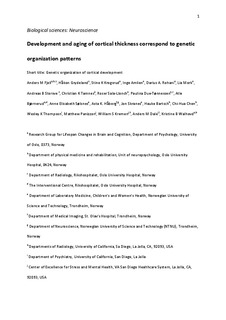| dc.contributor.author | Fjell, Anders Martin | |
| dc.contributor.author | Grydeland, Håkon | |
| dc.contributor.author | Krogsrud, Stine Kleppe | |
| dc.contributor.author | Amlien, Inge Kasbohm | |
| dc.contributor.author | Rohani, Darius Adam | |
| dc.contributor.author | Ferschmann, Lia | |
| dc.contributor.author | Storsve, Andreas Berg | |
| dc.contributor.author | Tamnes, Christian Krog | |
| dc.contributor.author | Sala-Llonch, Roser | |
| dc.contributor.author | Due-Tønnessen, Paulina | |
| dc.contributor.author | Bjørnerud, Atle | |
| dc.contributor.author | Sølsnes, Anne Elisabeth | |
| dc.contributor.author | Håberg, Asta | |
| dc.contributor.author | Skranes, Jon Sverre | |
| dc.contributor.author | Bartsch, Hauke | |
| dc.contributor.author | Chen, Chi-Hua | |
| dc.contributor.author | Thompson, Wesley K. | |
| dc.contributor.author | Panizzon, Matthew S. | |
| dc.contributor.author | Kremen, William S. | |
| dc.contributor.author | Dale, Anders M. | |
| dc.contributor.author | Walhovd, Kristine B | |
| dc.date.accessioned | 2016-02-05T14:17:18Z | |
| dc.date.accessioned | 2016-05-10T08:06:38Z | |
| dc.date.available | 2016-02-05T14:17:18Z | |
| dc.date.available | 2016-05-10T08:06:38Z | |
| dc.date.issued | 2015 | |
| dc.identifier.citation | Proceedings of the National Academy of Sciences of the United States of America 2015, 112(50):15462-15467 | nb_NO |
| dc.identifier.issn | 1091-6490 | |
| dc.identifier.uri | http://hdl.handle.net/11250/2388885 | |
| dc.description.abstract | There is a growing realization that
early life influences have lasting
impact on brain function and structure. Recent research has demon-
strated that genetic relationships in adults can be used to parcellate the
cortex into regions of maximal shared genetic influence, and a major
hypothesis is that genetically progr
ammed neurodevel
opmental events
cause a lasting impact on the organization of the cerebral cortex
observable decades later. Here we tested how developmental and
lifespan changes in cortical thickness fit the underlying genetic organi-
zational principles of co
rtical thickness in a longitudinal sample of 974
participants between 4.1 and 88.5 y of age with a total of 1,633 scans,
including 773 scans from children below 12 y. Genetic clustering of
cortical thickness was based on an independent dataset of 406 adult
twins. Developmental and adult age-
related changes in cortical thick-
ness followed closely the genetic organization of the cerebral cortex,
with change rates varying as a functi
on of genetic similarity between
regions. Cortical regions with overlapping genetic architecture showed
correlated development
al and adult age change trajectories and vice
versa for regions with low genetic overlap. Thus, effects of genes on
regional variations in cortical thickness in middle age can be traced to
regional differences in neurodevelopmental change rates and extrap-
olated to further adult aging-related cortical thinning. This finding
suggests that genetic factors contribute to cortical changes through life
and calls for a lifespan perspective i
n research aimed at identifying the
genetic and environmental determinants of cortical development
and aging. | nb_NO |
| dc.language.iso | eng | nb_NO |
| dc.publisher | National Academy of Sciences | nb_NO |
| dc.title | Development and aging of cortical thickness correspond to genetic organization patterns | nb_NO |
| dc.type | Journal article | nb_NO |
| dc.type | Peer reviewed | nb_NO |
| dc.date.updated | 2016-02-05T14:17:18Z | |
| dc.source.pagenumber | 15462–15467 | nb_NO |
| dc.source.volume | 112 | nb_NO |
| dc.source.issue | 50 | nb_NO |
| dc.identifier.doi | 10.1073/pnas.1508831112 | |
| dc.identifier.cristin | 1306103 | |
| dc.description.localcode | © National Academy of Sciences. This is the authors’ accepted and refereed manuscript to the article. | nb_NO |
